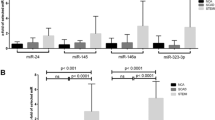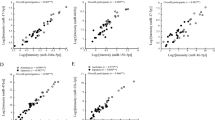Abstract
Studies have demonstrated the essential functions of microRNAs (miRNAs) in cardiovascular disease. Herein, we explored the roles of miR-126 and miR-223 in the prediction of plaque stability in carotid atherosclerosis (CA).Patients with CA (N = 52) and healthy volunteers (N = 25) were recruited as the study subjects and controls. First, a miRNA microarray was performed to analyze the differentially expressed miRNAs in the serum of normal controls and patients with CA. Next, the correlations of miR-223 and miR-126 expression with plaque stability-related factors were analyzed. Then, the predictive efficacy of miR-223 and miR-126 on plaque stability was analyzed by the ROC curve, and the targeting relationships of miR-223 and miR-126 with COX2 were verified. Finally, the relationship between COX2 expression and CA plaque stability was analyzed. miR-223 and miR-126 were decreased in the serum of CA patients and had good diagnostic efficacy for CA. miR-223 and miR-126 in the serum of CA patients with unstable plaques were lower than that in patients with stable plaques. miR-223 and miR-126 were negatively correlated with plaque instability-related indicators, while COX2, a direct target of miR-223 and miR-126, was positively related to plaque instability-related indicators. Lowly expressed miR-223 and miR-126 in the serum of CA patients can be used as indicators for plaque stability.
This is a preview of subscription content, access via your institution
Access options
Subscribe to this journal
Receive 12 digital issues and online access to articles
$119.00 per year
only $9.92 per issue
Buy this article
- Purchase on Springer Link
- Instant access to full article PDF
Prices may be subject to local taxes which are calculated during checkout





Similar content being viewed by others
Data availability
The data that support the findings of this study are available from the corresponding author upon reasonable request.
References
Forgo B, Medda E, Hernyes A, Szalontai L, Tarnoki DL, Tarnoki AD. Carotid artery atherosclerosis: a review on heritability and genetics. Twin Res Hum Genet. 2018;21:333–46.
Chen WH, Jin W, Lyu PY, Liu Y, Li R, Hu M, et al. Carotid atherosclerosis and cognitive impairment in nonstroke patients. Chin Med J (Engl). 2017;130:2375–9.
Volny O, Kasickova L, Coufalova D, Cimflova P, Novak J. microRNAs in cerebrovascular disease. Adv Exp Med Biol. 2015;888:155–95.
Alhaidar M, Algaeed M, Amdur R, Algahtani R, Majidi S, Sigounas D, et al. Early outcomes after carotid endarterectomy and carotid artery stenting for carotid stenosis in the ACS-NSQIP database. J Vasc Inter Neurol. 2018;10:52–6.
Novak J, Olejnickova V, Tkacova N, Santulli G. Mechanistic role of MicroRNAs in coupling lipid metabolism and atherosclerosis. Adv Exp Med Biol. 2015;887:79–100.
Giral H, Kratzer A, Landmesser U. MicroRNAs in lipid metabolism and atherosclerosis. Best Pr Res Clin Endocrinol Metab. 2016;30:665–76.
Sun W, Shen W, Yang S, Hu F, Li H, Zhu TH. miR-223 and miR-142 attenuate hematopoietic cell proliferation, and miR-223 positively regulates miR-142 through LMO2 isoforms and CEBP-beta. Cell Res. 2010;20:1158–69.
Guo JF, Zhang Y, Zheng QX, Zhang Y, Zhou HH, Cui LM. Association between elevated plasma microRNA-223 content and severity of coronary heart disease. Scand J Clin Lab Invest. 2018;78:373–8.
Wang S, Aurora AB, Johnson BA, Qi X, McAnally J, Hill JA, et al. The endothelial-specific microRNA miR-126 governs vascular integrity and angiogenesis. Dev Cell. 2008;15:261–71.
Chistiakov DA, Orekhov AN, Bobryshev YV. The role of miR-126 in embryonic angiogenesis, adult vascular homeostasis, and vascular repair and its alterations in atherosclerotic disease. J Mol Cell Cardiol. 2016;97:47–55.
Yang L, Chu Y, Wang Y, Zhao X, Xu W, Zhang P, et al. siRNA-mediated silencing of Wnt5a regulates inflammatory responses in atherosclerosis through the MAPK/NF-kappaB pathways. Int J Mol Med. 2014;34:1147–52.
Gitlin JM, Loftin CD. Cyclooxygenase-2 inhibition increases lipopolysaccharide-induced atherosclerosis in mice. Cardiovasc Res. 2009;81:400–7.
Tian HS, Zhou QG, Shao F. Relationship between arterial atheromatous plaque morphology and platelet-associated miR-126 and miR-223 expressions. Asian Pac J Trop Med. 2015;8:309–14.
Fujiwara W, Kato Y, Hayashi M, Sugishita Y, Okumura S, Yoshinaga M, et al. Serum microRNA-126 and -223 as new-generation biomarkers for sarcoidosis in patients with heart failure. J Cardiol. 2018;72:452–7.
Wang J, Bai X, Song Q, Fan F, Hu Z, Cheng G, et al. miR-223 inhibits lipid deposition and inflammation by suppressing toll-like receptor 4 signaling in macrophages. Int J Mol Sci. 2015;16:24965–82.
Yu XY, Chen JY, Zheng ZW, Wu H, Li LW, Zhang ZW, et al. Plasma miR-126 as a potential marker predicting major adverse cardiac events in dual antiplatelet-treated patients after percutaneous coronary intervention. EuroIntervention. 2013;9:546–54.
Gao J, Yang S, Wang K, Zhong Q, Ma A, Pan X. Plasma miR-126 and miR-143 as potential novel biomarkers for cerebral atherosclerosis. J Stroke Cerebrovasc Dis. 2019;28:38–43.
Abilleira S, Bevan S, Markus HS. The role of genetic variants of matrix metalloproteinases in coronary and carotid atherosclerosis. J Med Genet. 2006;43:897–901.
Martinez E, Martorell J, Riambau V. Review of serum biomarkers in carotid atherosclerosis. J Vasc Surg. 2020;71:329–41.
Hao XZ, Fan HM. Identification of miRNAs as atherosclerosis biomarkers and functional role of miR-126 in atherosclerosis progression through MAPK signalling pathway. Eur Rev Med Pharm Sci. 2017;21:2725–33.
Beloqui O, Paramo JA, Orbe J, Benito A, Colina I, Monasterio A, et al. Monocyte cyclooxygenase-2 overactivity: a new marker of subclinical atherosclerosis in asymptomatic subjects with cardiovascular risk factors? Eur Heart J. 2005;26:153–8.
Hong BK, Kwon HM, Lee BK, Kim D, Kim IJ, Kang SM, et al. Coexpression of cyclooxygenase-2 and matrix metalloproteinases in human aortic atherosclerotic lesions. Yonsei Med J. 2000;41:82–8.
Cipollone F, Prontera C, Pini B, Marini M, Fazia M, De Cesare D, et al. Overexpression of functionally coupled cyclooxygenase-2 and prostaglandin E synthase in symptomatic atherosclerotic plaques as a basis of prostaglandin E(2)-dependent plaque instability. Circulation. 2001;104:921–7.
Author information
Authors and Affiliations
Contributions
LZ contributed to the study concepts, study design; YW contributed to the literature research; LZ, YW contributed to the experimental studies and data acquisition; LZ, FQ contributed to the data analysis and statistical analysis; LZ contributed to the manuscript preparation. All authors read and approved the final manuscript.
Corresponding author
Ethics declarations
Competing interests
The authors declare no competing interests.
Ethics approval
This study was conducted following the Declaration of Helsinki in 1964 and approved by the ethics committee of Hangzhou Fuyang District Hospital of Traditional Chinese Medicine.
Additional information
Publisher’s note Springer Nature remains neutral with regard to jurisdictional claims in published maps and institutional affiliations.
Rights and permissions
Springer Nature or its licensor holds exclusive rights to this article under a publishing agreement with the author(s) or other rightsholder(s); author self-archiving of the accepted manuscript version of this article is solely governed by the terms of such publishing agreement and applicable law.
About this article
Cite this article
Zhu, L., Wang, Y. & Qiao, F. microRNA-223 and microRNA-126 are clinical indicators for predicting the plaque stability in carotid atherosclerosis patients. J Hum Hypertens 37, 788–795 (2023). https://doi.org/10.1038/s41371-022-00760-3
Received:
Revised:
Accepted:
Published:
Issue Date:
DOI: https://doi.org/10.1038/s41371-022-00760-3



